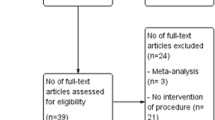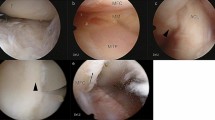Abstract
Purpose
Prior studies have compared unicompartmental knee arthroplasty (UKA) with high tibial osteotomy (HTO) suggesting that both procedures had good functional outcomes. But none had established the superiority of one of the two procedures for patients with high expectation including return to impact sport. The aim of this study was to compare functional outcomes and ability to return to impact sport of active patients defined with a pre-arthritis University of California and Los Angeles activity (UCLA) score > 8, after UKA or HTO procedures.
Methods
A retrospective review of patients with a pre-arthritis UCLA score > 8 operated between January 2014 and September 2017 has identified 91 patients with open-wedge HTO and 117 patients with UKA. A matching process based on age (± 3 years) and gender allowed to include 50 patients in each group for comparative analysis. Patient reported outcomes included Knee Osteoarthritis Outcomes Score (KOOS), UCLA Score, Knee Society Score (KSS) and time to return to sport or previous professional activities at 3, 6, 12 and 24 months following surgery.
Results
Mean time to return to sport activities or previous professional activities were significantly lower for the HTO group than for UKA group [respectively, 4.9 ± 2.2 months for HTO group vs 5.8 ± 6.2 months for UKA group (p = 0.006) and 3 ± 3 months for HTO group vs 4 ± 3 months for UKA group (p = 0.006)]. At 24-month follow-up, UCLA score, KOOS Sports Sub-score and KSS activity score were significantly higher for HTO group than for UKA group (Δ: 2 CI 95% (1.3–2.5 points) p < 0.0001, (Δ: 10.9 CI 95% (2.9–18.9 points) p = 0.04 and Δ: 7.8 CI 95% (2.4–13.4 points) p = 0.006, respectively) and 31 patients (62%) were practicing impact sport in the HTO group versus 14 (28%) in the UKA group (odd-ratio 4.2 CI 95% (1.8–9.7) p < 0.0001).
Conclusion
HTO offers statistically significant quicker return to sport activities and previous professional activities with a higher rate of patients able to practice impact activity (62% for HTO vs 28% for UKA) and better sports related functional scores at two years after surgery compared to UKA.
Level of evidence
III retrospective case–control study.

Similar content being viewed by others
References
Kurtz SM, Lau E, Ong K, Zhao K, Kelly M, Bozic KJ (2009) Future young patient demand for primary and revision joint replacement: national projections from 2010 to 2030. Clin Orthop Relat Res 467:2606–2612
Losina E, Thornhill TS, Rome BN, Wright J, Katz JN (2012) The dramatic increase in total knee replacement utilization rates in the United States cannot be fully explained by growth in population size and the obesity epidemic. J Bone Jt Surg Am 94:201–207
Lyons MC, MacDonald SJ, Somerville LE, Naudie DD, McCalden RW (2012) Unicompartmental versus total knee arthroplasty database analysis: is there a winner? Clin Orthop Relat Res 470:84–90
Scuderi GR, Bourne RB, Noble PC, Benjamin JB, Lonner JH, Scott WN (2012) The new knee society knee scoring system. Clin Orthop 470:3–19
Dahl WA, Robertsson O, Lidgren L (2010) Surgery for knee osteoarthritis in younger patients. Acta Orthop 81:161–164
Schmalzried TP, Shepherd EF, Dorey FJ, Jackson WO, Rosa M, Favae F, McKellop HA, McClung CD, Martell J, Moreland JR, Amstutz HC (2000) The John Charnley Award Wear is a function of use, not time. Clin Orthop 2000:36–46
Witjes S, Gouttebarge V, Kuijer PPFM, Van GRCI, Poolman RW, Kerkhoffs GMMJ (2016) Return to sports and physical activity after total and unicondylar knee arthroplasty: a systematic review and meta-analysis. Sports Med 46:269–292
Berend KR, Berend ME, Dalury DF, Argenson J-N, Dodd CA, Scott RD (2015) Consensus statement on indications and contraindications for medial unicompartmental knee arthroplasty. J Surg Orthop Adv 24:252–256
Kleeblad LJ, van der List JP, Zuiderbaan HA, Pearle AD (2018) Larger range of motion and increased return to activity, but higher revision rates following unicompartmental versus total knee arthroplasty in patients under 65: a systematic review. Knee Surg Sports Traumatol Arthrosc 26:1811–1822
Naal FD, Fischer M, Preuss A, Goldhahn J, von Knoch F, Preiss S, Munzinger U, Drobny T (2007) Return to sports and recreational activity after unicompartmental knee arthroplasty. Am J Sports Med 35:1688–1695
Brinkman J-M, Lobenhoffer P, Agneskirchner JD, Staubli AE, Wymenga AB, van Heerwaarden RJ (2008) Osteotomies around the knee. J Bone Jt Surg Br 90:1548–1557
Bragonzoni L, Rovini E, Barone G, Cavallo F, Zaffagnini S, Benedetti MG (2019) How proprioception changes before and after total knee arthroplasty: a systematic review. Gait Posture 72:1–11
Wautier D, Thienpont E (2017) Changes in anteroposterior stability and proprioception after different types of knee arthroplasty. Knee Surg Sports Traumatol Arthrosc 25:1792–1800
Cao Z, Mai X, Wang J, Feng E, Huang Y (2018) Unicompartmental knee arthroplasty vs high tibial osteotomy for knee osteoarthritis: a systematic review and meta-analysis. J Arthroplasty 33:952–959
Kim MS, Koh IJ, Sohn S, Jeong JH, In Y (2018) Unicompartmental knee arthroplasty is superior to high tibial osteotomy in post-operative recovery and participation in recreational and sports activities. Int Orthop 43:2493–2501
Mancuso F, Hamilton TW, Kumar V, Murray DW, Pandit H (2016) Clinical outcome after UKA and HTO in ACL deficiency: a systematic review. Knee Surg Sports Traumatol Arthrosc 24:112–122
Hoorntje A, Witjes S, Kuijer PPFM, Koenraadt KLM, van Geenen RCI, Daams JG, Getgood A, Kerkhoffs GMMJ (2017) High rates of return to sports activities and work after osteotomies around the knee: a systematic review and meta-analysis. Sports Med 47:2219–2244
Waldstein W, Kolbitsch P, Koller U, Boettner F, Windhager R (2017) Sport and physical activity following unicompartmental knee arthroplasty: a systematic review. Knee Surg Sports Traumatol Arthrosc 25:717–728
Ahlbäck S (1968) Osteoarthrosis of the knee. A radiographic investigation. Acta Radiol Diagn Suppl 277:7–72
Argenson J-NA, Parratte S, Flecher X, Aubaniac J-M (2007) Unicompartmental knee arthroplasty: technique through a mini-incision. Clin Orthop 464:32–36
Elson DW, Petheram TG, Dawson MJ (2015) High reliability in digital planning of medial opening wedge high tibial osteotomy, using Miniaci’s method. Knee Surg Sports Traumatol Arthrosc 23:2041–2048
Munier M, Donnez M, Ollivier M, Flecher X, Chabrand P, Argenson JN, Parratte S (2017) Can three-dimensional patient-specific cutting guides be used to achieve optimal correction for high tibial osteotomy? Pilot study. Orthop Traumatol Surg Res 103:245–250
Faschingbauer M, Nelitz M, Urlaub S, Reichel H, Dornacher D (2015) Return to work and sporting activities after high tibial osteotomy. Int Orthop 39:1527–1534
Takeuchi R, Ishikawa H, Kumagai K, Yamaguchi Y, Chiba N, Akamatsu Y, Saito T (2012) Fractures around the lateral cortical hinge after a medial opening-wedge high tibial osteotomy: a new classification of lateral hinge fracture. J Arthrosc Relat Surg 28:85–94
Ornetti P, Parratte S, Gossec L, Tavernier C, Argenson J-N, Roos EM, Guillemin F, Maillefert JF (2008) Cross-cultural adaptation and validation of the French version of the Knee injury and Osteoarthritis Outcome Score (KOOS) in knee osteoarthritis patients. Osteoarthr Cartil 16:423–428
Zahiri CA, Schmalzried TP, Szuszczewicz ES, Amstutz HC (1998) Assessing activity in joint replacement patients. J Arthroplasty 13:890–895
Roos EM, Lohmander LS (2003) The Knee injury and Osteoarthritis Outcome Score (KOOS): from joint injury to osteoarthritis. Health Qual Life Outcomes 1:1–8
Borus T, Thornhill T (2008) Unicompartmental knee arthroplasty. J Am Acad Orthop Surg 16:9–18
Zuiderbaan HA, van der List JP, Kleeblad LJ, Appelboom P, Kort NP, Pearle AD, Rademakers MV (2016) Modern indications, results, and global trends in the use of unicompartmental knee arthroplasty and high tibial osteotomy in the treatment of isolated medial compartment osteoarthritis. Am J Orthop 45:E355–E361
Pennington DW, Swienckowski JJ, Lutes WB, Drake GN (2003) Unicompartmental knee arthroplasty in patients sixty years of age or younger. J Bone Jt Surg Am 85:1968–1973
Bastard C, Mirouse G, Potage D, Silbert H, Roubineau F, Hernigou P, Flouzat-Lachaniette CH (2017) Return to sports and quality of life after high tibial osteotomy in patients under 60 years of age. Orthop Traumatol Surg 103:1189–1191
Bonnin MP, Laurent JR, Zadegan F, Badet R, Pooler Archbold HA, Servien E (2011) Can patients really participate in sport after high tibial osteotomy? Knee Surg Sports Traumatol Arthrosc 21:64–73
Yim JH, Song EK, Seo HY, Kim MS, Seon JK (2013) Comparison of high tibial osteotomy and unicompartmental knee arthroplasty at a minimum follow-up of 3 years. J Arthroplasty 28:243–247
Ekhtiari S, Haldane CE, De SD, Simunovic N, Musahl V, Ayeni OR (2016) Return to work and sport following high tibial osteotomy. J Bone Jt Surg Am 98:1568–1577
Hoorntje A, Kuijer PPFM, van Ginneken BT, Koenraadt KLM, van Geenen RCI, Kerkhoffs GMMJ, van Heerwaarden RJ (2019) Prognostic factors for return to sport after high tibial osteotomy: a directed acyclic graph approach. Am J Sports Med 47:1854–1862
Cho WJ, Kim JM, Kim WK, Kim DE, Kim NK, Il BS (2018) Mobile-bearing unicompartmental knee arthroplasty in old-aged patients demonstrates superior short-term clinical outcomes to open-wedge high tibial osteotomy in middle-aged patients with advanced isolated medial osteoarthritis. Int Orthop 42:2357–2363
Takeuchi R, Umemoto Y, Aratake M, Bito H, Saito I, Kumagai K, Sasaki Y, Akamatsu Y, Ishikawa H, Koshino T, Saito T (2010) A mid term comparison of open wedge high tibial osteotomy vs unicompartmental knee arthroplasty for medial compartment osteoarthritis of the knee. J Orthop Surg 5:1–8
Wiering B, de Boer D, Delnoij D (2018) Meeting patient expectations: patient expectations and recovery after hip or knee surgery. Musculoskelet Surg 102:231–240
Funding
No funding was required for this study.
Author information
Authors and Affiliations
Contributions
CJ and FG have made substantial contributions to acquisition of data, or analysis and interpretation of data. AP, AS, JNA, and SP have been involved in drafting the manuscript or revising it critically. MO has made substantial contributions to conception and design, or acquisition of data, or analysis and interpretation of data. Every authors have given final approval of the version to be published and agree to be accountable for all aspects of the work in ensuring that questions related to the accuracy or integrity of any part of the work are appropriately investigated and resolved.
Corresponding author
Ethics declarations
Conflict of interest
Local ethic committee approved our study protocol prior to investigation. Some of the authors disclosed potential conflict of interest.
Ethical approval
Local Ethical Committee approval was obtained prior to study’s initiation (Comité Informatique et Liberté (CIL)/Assistance Publique des Hopitaux de Marseille (APHM)/ Registration Number 2019–17-03)).
Additional information
Publisher's Note
Springer Nature remains neutral with regard to jurisdictional claims in published maps and institutional affiliations.
Rights and permissions
About this article
Cite this article
Jacquet, C., Gulagaci, F., Schmidt, A. et al. Opening wedge high tibial osteotomy allows better outcomes than unicompartmental knee arthroplasty in patients expecting to return to impact sports. Knee Surg Sports Traumatol Arthrosc 28, 3849–3857 (2020). https://doi.org/10.1007/s00167-020-05857-1
Received:
Accepted:
Published:
Issue Date:
DOI: https://doi.org/10.1007/s00167-020-05857-1




